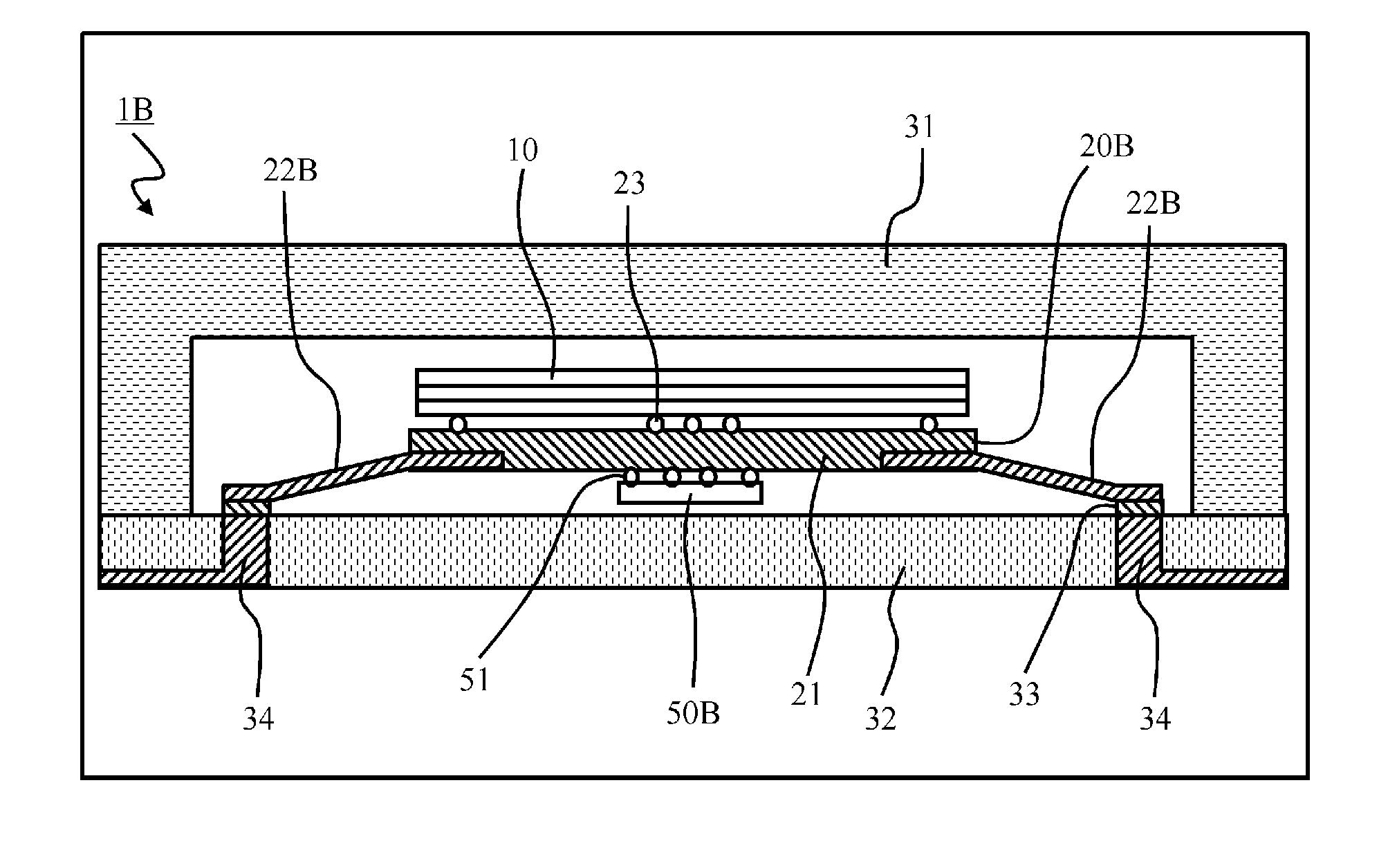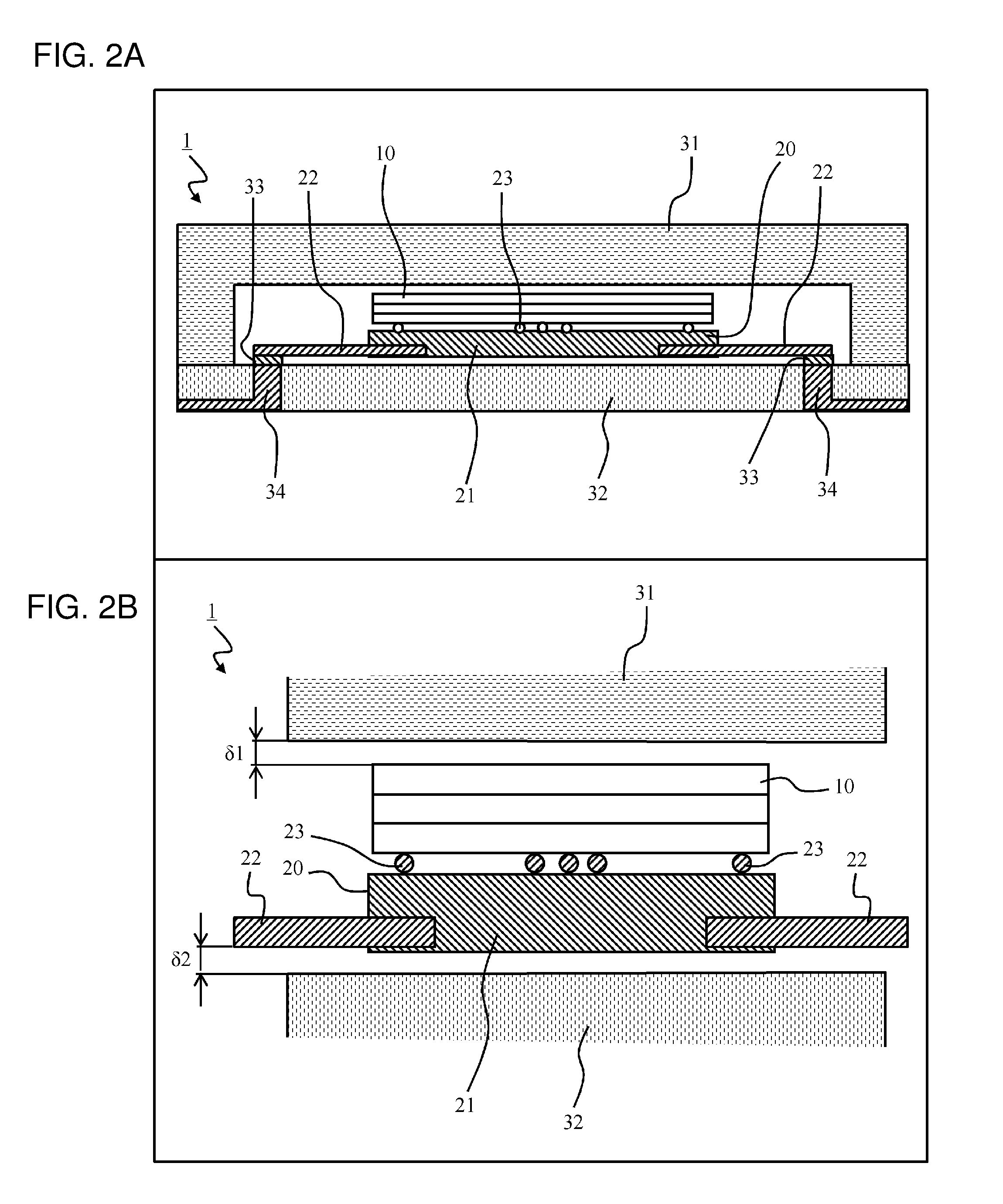Physical Quantity Sensor
a sensor and physical technology, applied in the field of physical quantity sensors, can solve problems such as adversely affecting the measurement accuracy, and achieve the effect of increasing the measurement accuracy of the sensor elemen
- Summary
- Abstract
- Description
- Claims
- Application Information
AI Technical Summary
Benefits of technology
Problems solved by technology
Method used
Image
Examples
example 1
[0035]A first example will be described using FIGS. 1 and 2. FIG. 1 is an exploded perspective view of a physical quantity sensor 1 according to the example. FIG. 2 are cross-sectional views of the physical quantity sensor.
[0036]The physical quantity sensor 1 is, for example, a device that detects a predetermined physical quantity (physical quantity as a measurement target) such as acceleration or angular velocity, and outputs a signal. The physical quantity sensor 1 is configured to include, for example, the sensor chip 10, the lead substrate 20, and the package substrate 30.
[0037]When a physical quantity as a measurement target is applied, a three-dimensional structure in the interior of the sensor chip 10 is deformed, and the sensor chip 10 outputs an electrical signal. The sensor chip 10 uses a change in capacitance or a change in resistance in response to the deformation of the three-dimensional structure to convert the deformation into an electrical signal. The sensor chip 10 ...
example 2
[0053]A second example will be described with reference to FIGS. 3 and 4. The following examples including the example correspond to modified examples of the first example, and therefore, the differences from the first example will be mainly described. A physical quantity sensor 1A of the example incorporates the amplifier circuit board 50 therein. FIG. 3 is an exploded perspective view of the physical quantity sensor 1A. FIG. 4 are cross-sectional views of the physical quantity sensor 1A.
[0054]The physical quantity sensor 1A is configured to include the sensor chip 10, the lead substrate 20, a package substrate 30, and the amplifier circuit board 50. The amplifier circuit board 50, which is an example of the “predetermined board” that processes a signal from the sensor chip 10, amplifies a signal of the sensor chip 10 and outputs the signal. Hereinafter, the amplifier circuit board 50 is sometimes abbreviated as the circuit board 50.
[0055]The circuit board 50 is formed into a squar...
example 3
[0059]A third example will be described using FIGS. 5 and 6. A physical quantity sensor 1B of the example includes a circuit board 50B mounted on the lower surface of the electrode substrate 21 of a lead substrate 20. Further, in the physical quantity sensor 1B of the example, leads 22 are slightly bent so as to forma space for disposing the circuit board 50B between the lower surface of the electrode substrate 21 and the upper surface of the substrate portion 32. FIG. 5 is an exploded perspective view of the physical quantity sensor 1B. FIG. 6 are cross-sectional views of the physical quantity sensor 1B.
[0060]The physical quantity sensor 1B is configured to include the sensor chip 10, the lead substrate 20B, the package substrate 30, and the circuit board 50B. The leads 22B are bent obliquely downward and extracted, as shown in FIG. 6, from the four sides of the electrode substrate 21 of the lead substrate 20B.
[0061]When the electrode plate 21 is assumed as a reference horizontal p...
PUM
| Property | Measurement | Unit |
|---|---|---|
| physical quantity | aaaaa | aaaaa |
| rigidity | aaaaa | aaaaa |
| stress | aaaaa | aaaaa |
Abstract
Description
Claims
Application Information
 Login to View More
Login to View More - R&D
- Intellectual Property
- Life Sciences
- Materials
- Tech Scout
- Unparalleled Data Quality
- Higher Quality Content
- 60% Fewer Hallucinations
Browse by: Latest US Patents, China's latest patents, Technical Efficacy Thesaurus, Application Domain, Technology Topic, Popular Technical Reports.
© 2025 PatSnap. All rights reserved.Legal|Privacy policy|Modern Slavery Act Transparency Statement|Sitemap|About US| Contact US: help@patsnap.com



